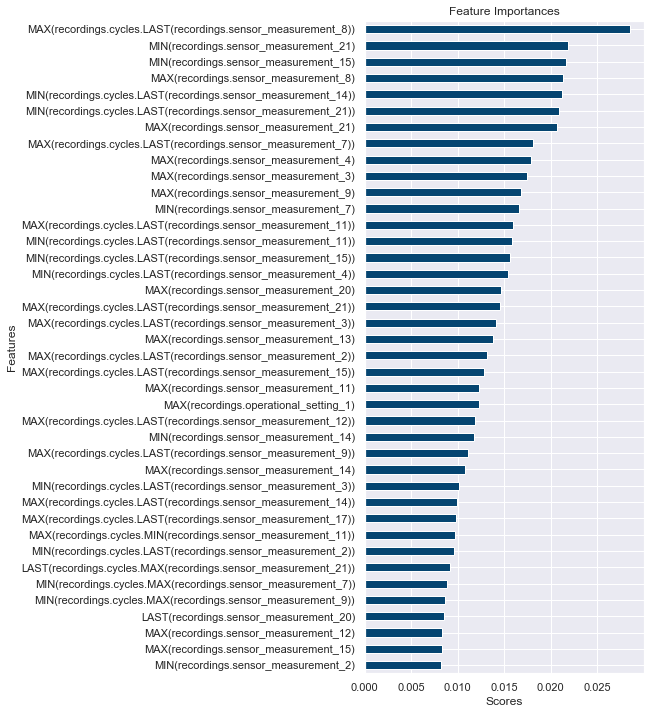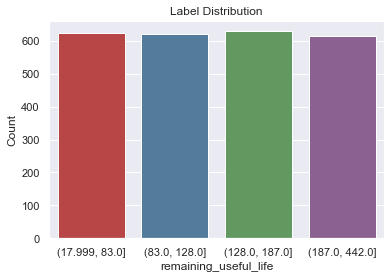Predict Remaining Useful Life¶
In this example, we will generate labels using Compose on data provided by NASA simulating turbofan engine degradation. Then, the labels are used to generate features and train a machine learning model to predict the Remaining Useful Life (RUL) of an engine.
[1]:
%matplotlib inline
import composeml as cp
import featuretools as ft
import pandas as pd
import data
from sklearn.model_selection import train_test_split
from sklearn.ensemble import RandomForestClassifier
from sklearn.metrics import classification_report
Load Data¶
In this dataset, we have 249 engines (engine_no) which are monitored over time (time_in_cycles). Each engine had operational_settings and sensor_measurements recorded for each cycle. The Remaining Useful Life (RUL) is the amount of cycles an engine has left before it needs maintenance. What makes this dataset special is that the engines run all the way until failure, giving us precise RUL information for every engine at every point in time.
You can download the data directly from NASA here. After downloading the data, you can set the file parameter as an absolute path to train_FD004.txt. With the file in place, we preview the data to get an idea on how to observations look.
[2]:
df = data.load('data/train_FD004.txt')
df[df.columns[:7]].head()
[2]:
| engine_no | time_in_cycles | operational_setting_1 | operational_setting_2 | operational_setting_3 | sensor_measurement_1 | sensor_measurement_2 | |
|---|---|---|---|---|---|---|---|
| 0 | 1 | 1 | 42.0049 | 0.8400 | 100.0 | 445.00 | 549.68 |
| 1 | 1 | 2 | 20.0020 | 0.7002 | 100.0 | 491.19 | 606.07 |
| 2 | 1 | 3 | 42.0038 | 0.8409 | 100.0 | 445.00 | 548.95 |
| 3 | 1 | 4 | 42.0000 | 0.8400 | 100.0 | 445.00 | 548.70 |
| 4 | 1 | 5 | 25.0063 | 0.6207 | 60.0 | 462.54 | 536.10 |
Generate Labels¶
Now with the observations loaded, we are ready to generate labels for our prediction problem.
Define Labeling Function¶
To get started, we define the labeling function that will return the RUL given the remaining observations of an engine.
[3]:
def remaining_useful_life(df):
return len(df) - 1
Create Label Maker¶
With the labeling function, we create the label maker for our prediction problem. To process the RUL for each engine, we set the target_entity to the engine number. By default, the window_size is set to the total observation size to contain the remaining observations for each engine.
[4]:
lm = cp.LabelMaker(
target_entity='engine_no',
time_index='time',
labeling_function=remaining_useful_life,
)
Search Labels¶
Let’s imagine we want to make predictions on turbines that are up and running. Turbines in general don’t fail before 120 cycles, so we will only make labels for engines that reach at least 100 cycles. To do this, the minimum_data parameter is set to 100. Using Compose, we can easily tweak this parameter as the requirements of our model changes. Additionally, we set gap to one to create labels on every cycle and limit the search to 10 examples for each engine.
See also
For more details on how the label maker works, see Main Concepts.
[5]:
lt = lm.search(
df.sort_values('time'),
num_examples_per_instance=10,
minimum_data=100,
gap=1,
verbose=True,
)
lt.head()
Elapsed: 00:01 | Remaining: 00:00 | Progress: 100%|██████████| engine_no: 2490/2490
[5]:
| engine_no | time | remaining_useful_life | |
|---|---|---|---|
| id | |||
| 0 | 1 | 2000-01-01 16:40:00 | 220 |
| 1 | 1 | 2000-01-01 16:50:00 | 219 |
| 2 | 1 | 2000-01-01 17:00:00 | 218 |
| 3 | 1 | 2000-01-01 17:10:00 | 217 |
| 4 | 1 | 2000-01-01 17:20:00 | 216 |
Continuous Labels¶
The labeling function we defined returns continuous labels which can be used to train a regression model for our predictin problem. Alternatively, there are label transforms available to further process these labels into discrete values. In which case, can be used to train a classification model.
Describe Labels¶
Let’s print out the settings and transforms that were used to make the continuous labels. This is useful as a reference for understanding how the labels were generated from raw data.
[6]:
lt.describe()
Settings
--------
gap 1
label_type continuous
labeling_function remaining_useful_life
minimum_data 100
num_examples_per_instance 10
target_entity engine_no
window_size 61249
Transforms
----------
No transforms applied
Let’s plot the labels to get additional insight of the RUL.
Discrete Labels¶
Let’s further process the labels into discrete values. We divide the RUL into quartile bins to predict which range an engine’s RUL will fall in.
[8]:
lt = lt.bin(4, quantiles=True)
Describe Labels¶
Next, let’s print out the settings and transforms that were used to make the discrete labels. This time we can see the label distribution which is useful for determining if we have imbalanced labels. Also, we can see that the label type changed from continuous to discrete and the binning transform used in the previous step is included below.
[9]:
lt.describe()
Label Distribution
------------------
(128.0, 187.0] 629
(17.999, 83.0] 625
(187.0, 442.0] 614
(83.0, 128.0] 622
Total: 2490
Settings
--------
gap 1
label_type discrete
labeling_function remaining_useful_life
minimum_data 100
num_examples_per_instance 10
target_entity engine_no
window_size 61249
Transforms
----------
1. bin
- bins: 4
- labels: None
- quantiles: True
- right: True
Let’s plot the labels to get additional insight of the RUL.
Count by Time¶
This plot shows the label count accumulated across cutoff times.
[11]:
lt.plot.count_by_time();

Generate Features¶
Now, we are ready to generate features for our prediction problem.
Create Entity Set¶
To get started, let’s create an EntitySet for the observations.
See also
For more details on working with entity sets, see loading_data/using_entitysets.
[12]:
es = ft.EntitySet('observations')
es.entity_from_dataframe(
dataframe=df,
entity_id='recordings',
index='id',
time_index='time',
make_index=True,
)
es.normalize_entity(
base_entity_id='recordings',
new_entity_id='engines',
index='engine_no',
)
es.normalize_entity(
base_entity_id='recordings',
new_entity_id='cycles',
index='time_in_cycles',
)
[12]:
Entityset: observations
Entities:
recordings [Rows: 61249, Columns: 28]
engines [Rows: 249, Columns: 2]
cycles [Rows: 543, Columns: 2]
Relationships:
recordings.engine_no -> engines.engine_no
recordings.time_in_cycles -> cycles.time_in_cycles
Describe Entity Set¶
To get an idea on how the entity set is structured, we can plot a diagram.
[13]:
es.plot()
[13]:
Create Feature Matrix¶
To simplify the calculation for the feature matrix, we only use 20 percent of the labels.
[14]:
lt = lt.sample(frac=.2, random_state=0)
Let’s generate features that correspond to the labels. To do this, we set the target_entity to engines and the cutoff_time to our labels so that the features are calculated for each engine only using data up to and including the cutoff time of each label. Notice that the output of Compose integrates easily with Featuretools.
See also
For more details on calculating features using cutoff times, see automated_feature_engineering/handling_time.
[15]:
fm, fd = ft.dfs(
entityset=es,
target_entity='engines',
agg_primitives=['last', 'max', 'min'],
trans_primitives=[],
cutoff_time=lt,
cutoff_time_in_index=True,
max_depth=3,
verbose=True,
)
fm.head()
Built 292 features
Elapsed: 03:05 | Progress: 100%|██████████
[15]:
| LAST(recordings.sensor_measurement_2) | LAST(recordings.sensor_measurement_21) | LAST(recordings.sensor_measurement_1) | LAST(recordings.sensor_measurement_4) | LAST(recordings.sensor_measurement_5) | LAST(recordings.sensor_measurement_11) | LAST(recordings.sensor_measurement_7) | LAST(recordings.sensor_measurement_9) | LAST(recordings.sensor_measurement_19) | LAST(recordings.sensor_measurement_18) | ... | MIN(recordings.cycles.LAST(recordings.sensor_measurement_11)) | MIN(recordings.cycles.LAST(recordings.sensor_measurement_3)) | MIN(recordings.cycles.MIN(recordings.sensor_measurement_16)) | MIN(recordings.cycles.MAX(recordings.operational_setting_1)) | MIN(recordings.cycles.LAST(recordings.sensor_measurement_18)) | MIN(recordings.cycles.MIN(recordings.sensor_measurement_17)) | MIN(recordings.cycles.MAX(recordings.operational_setting_3)) | MIN(recordings.cycles.MIN(recordings.sensor_measurement_10)) | MIN(recordings.cycles.MAX(recordings.sensor_measurement_18)) | remaining_useful_life | ||
|---|---|---|---|---|---|---|---|---|---|---|---|---|---|---|---|---|---|---|---|---|---|---|
| engine_no | time | |||||||||||||||||||||
| 233 | 2001-02-02 07:30:00 | 643.08 | 23.3473 | 518.67 | 1399.84 | 14.62 | 47.49 | 554.09 | 9068.13 | 100.00 | 2388 | ... | 36.49 | 1250.55 | 0.02 | 42.0070 | 1915 | 302 | 100.0 | 0.93 | 2388 | (128.0, 187.0] |
| 146 | 2000-09-04 07:50:00 | 554.79 | 8.8768 | 449.44 | 1118.14 | 5.48 | 41.61 | 195.73 | 8346.50 | 100.00 | 2223 | ... | 36.45 | 1254.83 | 0.02 | 42.0067 | 1915 | 302 | 100.0 | 0.93 | 2388 | (187.0, 442.0] |
| 105 | 2000-06-26 11:10:00 | 549.28 | 6.3080 | 445.00 | 1127.19 | 3.91 | 42.03 | 139.18 | 8332.78 | 100.00 | 2212 | ... | 36.36 | 1251.50 | 0.02 | 42.0067 | 1915 | 302 | 100.0 | 0.93 | 2388 | (17.999, 83.0] |
| 240 | 2001-02-13 23:20:00 | 642.73 | 23.2631 | 518.67 | 1411.59 | 14.62 | 47.50 | 552.91 | 9048.65 | 100.00 | 2388 | ... | 36.39 | 1251.07 | 0.02 | 42.0070 | 1915 | 302 | 100.0 | 0.93 | 2388 | (17.999, 83.0] |
| 229 | 2001-01-26 09:00:00 | 536.44 | 8.5711 | 462.54 | 1047.57 | 7.05 | 36.54 | 174.64 | 8008.89 | 84.93 | 1915 | ... | 36.43 | 1249.84 | 0.02 | 42.0070 | 1915 | 302 | 100.0 | 0.93 | 2388 | (128.0, 187.0] |
5 rows × 293 columns
Machine Learning¶
Now, we are ready to create a machine learning model for our prediction problem.
Preprocess Features¶
Let’s extract the labels from the feature matrix and fill any missing values with zeros. Additionally, the categorical features are one-hot encoded.
[16]:
y = fm.pop('remaining_useful_life')
y = y.astype('str')
x = fm.fillna(0)
x, fe = ft.encode_features(x, fd)
Split Labels and Features¶
Then, we split the labels and features each into training and testing sets.
[17]:
x_train, x_test, y_train, y_test = train_test_split(
x,
y,
train_size=.8,
test_size=.2,
random_state=0,
)
Train Model¶
Next, we train a random forest classifer on the training set.
[18]:
clf = RandomForestClassifier(n_estimators=10, random_state=0)
clf.fit(x_train, y_train)
[18]:
RandomForestClassifier(bootstrap=True, class_weight=None, criterion='gini',
max_depth=None, max_features='auto', max_leaf_nodes=None,
min_impurity_decrease=0.0, min_impurity_split=None,
min_samples_leaf=1, min_samples_split=2,
min_weight_fraction_leaf=0.0, n_estimators=10,
n_jobs=None, oob_score=False, random_state=0, verbose=0,
warm_start=False)
Test Model¶
Lastly, we test the model performance by evaluating predictions on the testing set.
[19]:
y_hat = clf.predict(x_test)
print(classification_report(y_test, y_hat))
precision recall f1-score support
(128.0, 187.0] 0.65 0.79 0.71 28
(17.999, 83.0] 0.64 0.73 0.68 22
(187.0, 442.0] 0.81 0.84 0.82 25
(83.0, 128.0] 0.67 0.40 0.50 25
accuracy 0.69 100
macro avg 0.69 0.69 0.68 100
weighted avg 0.69 0.69 0.68 100
Feature Importances¶
This plot is based on scores from the model to show which features are important for predictions.
[20]:
feature_importances = zip(x_train.columns, clf.feature_importances_)
feature_importances = pd.Series(dict(feature_importances))
feature_importances = feature_importances.rename_axis('Features')
feature_importances = feature_importances.sort_values()
top_features = feature_importances.tail(40)
plot = top_features.plot(kind='barh', figsize=(5, 12), color='#054571')
plot.set_title('Feature Importances')
plot.set_xlabel('Scores');


